 Auset – (Isis in Greek) – one of the earliest and most beloved representations of the Goddess was known both as the Giver of Life and the Divine Mourner. She is the sacred model of African woman-hood and matriarchal agency who is at the genesis of life itself and its passage into the afterworld. The traditional practice in which African women preside over matters of death in their performance of funeral songs is very much in keeping with the role of Auset’s lamentations. It also fits the Shulamite’s role in the Song of Songs where she is referred to as the “fairest among women” because of who her beloved is; his special regard for her; and the regenerative role she is especially qualified to play as his “sister” and his “spouse.”
Auset – (Isis in Greek) – one of the earliest and most beloved representations of the Goddess was known both as the Giver of Life and the Divine Mourner. She is the sacred model of African woman-hood and matriarchal agency who is at the genesis of life itself and its passage into the afterworld. The traditional practice in which African women preside over matters of death in their performance of funeral songs is very much in keeping with the role of Auset’s lamentations. It also fits the Shulamite’s role in the Song of Songs where she is referred to as the “fairest among women” because of who her beloved is; his special regard for her; and the regenerative role she is especially qualified to play as his “sister” and his “spouse.”
 Auset – “Queen of Heaven,” “Giver of Life” and “Divine Mourner” – is the beloved sister and spouse of Ausar or Osiris (Greek), who served as King of Egypt before he became God of the underworld and the afterlife. Credited with having taught Egyptians agriculture, irrigation, construction, and hieroglyphic writing using the script invented by Djehuti or Thoth (Greek) during his reign, Ausar is murdered by his jealous brother Set or Seth (Greek) who thereafter imposes his own tyrannical rule over Kemet / ancient Egypt.
Auset – “Queen of Heaven,” “Giver of Life” and “Divine Mourner” – is the beloved sister and spouse of Ausar or Osiris (Greek), who served as King of Egypt before he became God of the underworld and the afterlife. Credited with having taught Egyptians agriculture, irrigation, construction, and hieroglyphic writing using the script invented by Djehuti or Thoth (Greek) during his reign, Ausar is murdered by his jealous brother Set or Seth (Greek) who thereafter imposes his own tyrannical rule over Kemet / ancient Egypt.
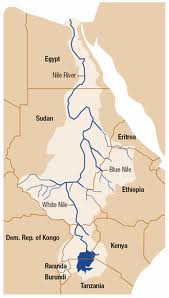
Nile River and Source
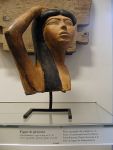
Statue depicting Auset Lamenting
Auset’s mourning as she gathers and mummifies the pieces of her beloved’s body that Set has scattered throughout the land – or diaspora, in other words – becomes a hallmark of how this goddess came to be identified over the centuries by her numerous followers. The language Auset cries in as Ausar’s funerary deity is a lamentation and plea for her beloved to return to life. The sacred tears she sheds over him are said to be the cause of the annual flooding of the Nile River, which is still commemorated by Egyptian Muslims in “The Night of the [Tear-]Drop” festival. Auset is able to magically resurrect her consort. Their son who is posthumously conceived – Heru or Horus (Greek) – in manhood avenges his father’s death and overthrows his uncle Set’s evil rule.
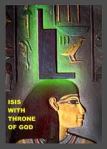 Goddess of the home and person rather than of the temple and priest, Auset nevertheless comes to represent the throne of Kemet upon whose lap Pharaohs, like her own son, were enthroned/enstooled and reigned. “Justice and judgment are the foundation of thy throne” (Psalm 89: 14) originated from her Goddess principles of Right, Justice, and Truth (Ma’at). The Throne-Mother’s nature-based magical powers of resurrection/reincarnation in concert with her lamentations are a matriarchal mystery ritualized throughout Africa. Associated with Mut, Hathor, Bast, Ma’at, Sekhmet, Neith among others, the Goddess of Goddesses – Auset – is the ideal and universal sister, mother, and spouse who hears the cries of the downtrodden, children, her beloved… and responds with compassion and wisdom.
Goddess of the home and person rather than of the temple and priest, Auset nevertheless comes to represent the throne of Kemet upon whose lap Pharaohs, like her own son, were enthroned/enstooled and reigned. “Justice and judgment are the foundation of thy throne” (Psalm 89: 14) originated from her Goddess principles of Right, Justice, and Truth (Ma’at). The Throne-Mother’s nature-based magical powers of resurrection/reincarnation in concert with her lamentations are a matriarchal mystery ritualized throughout Africa. Associated with Mut, Hathor, Bast, Ma’at, Sekhmet, Neith among others, the Goddess of Goddesses – Auset – is the ideal and universal sister, mother, and spouse who hears the cries of the downtrodden, children, her beloved… and responds with compassion and wisdom.
 Ancient Egyptians addressed Auset as “Mistress of the gods, thou bearer of wings, thou lady of the red apparel, queen of the crowns of the South and North, only One… superior to whom the gods cannot be, thou mighty one of enchantments (or, Words of Power)… thou who art pre-eminent, mistress and lady of the tomb, Mother in the horizon of heaven… Praise be unto thee, O Lady, who art mightier than the gods, words of adoration rise unto thee from the Eight Gods of Hermopolis. The living souls who are in their hidden places praise the mystery of thee, O thou who art their mother, thou source from which they sprang, who makest for them a place in the hidden Underworld, who makest sound their bones and preservest them from terror, who makest them strong in the abode of everlastingness.”
Ancient Egyptians addressed Auset as “Mistress of the gods, thou bearer of wings, thou lady of the red apparel, queen of the crowns of the South and North, only One… superior to whom the gods cannot be, thou mighty one of enchantments (or, Words of Power)… thou who art pre-eminent, mistress and lady of the tomb, Mother in the horizon of heaven… Praise be unto thee, O Lady, who art mightier than the gods, words of adoration rise unto thee from the Eight Gods of Hermopolis. The living souls who are in their hidden places praise the mystery of thee, O thou who art their mother, thou source from which they sprang, who makest for them a place in the hidden Underworld, who makest sound their bones and preservest them from terror, who makest them strong in the abode of everlastingness.”
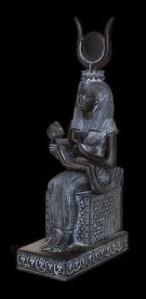 The cult of the Virgin Mary originally entered the Greco-Roman world as worship of Throne Mother and Queen of Heaven Auset, whose iconic breast-feeding of her son Heru was transformed into the popular Madonna and Child version. Auset’s awakening of Ausar from the dead and her posthumous conception of a son (Heru) is echoed in the “virgin” birth of Jesus Christ and later resurrection from his tomb by Mary Magdalene after he lived a life performing miracles once ascribed to the Goddess. Roman Christian Pastors evolved from the Pastophori or “pastors/ shepherds/servants of Isis,” and were among those who advanced the legend of Mary and her son Jesus taking refuge in Egypt in the sycamore tree. Sacred to Auset-Hathor, this tree is now promoted as a Christian pilgrimage site in Mataria, Egypt. Indeed much that has been promoted as Christianity – such as the Ten Commandments which assume a Euro-patriarchal posture in their reinterpretation of the Negative Confessions (found in the ancient funerary text referred to as The Book of the Dead or Book of Coming Forth By Day) – has its African origins in ancient Egypt.
The cult of the Virgin Mary originally entered the Greco-Roman world as worship of Throne Mother and Queen of Heaven Auset, whose iconic breast-feeding of her son Heru was transformed into the popular Madonna and Child version. Auset’s awakening of Ausar from the dead and her posthumous conception of a son (Heru) is echoed in the “virgin” birth of Jesus Christ and later resurrection from his tomb by Mary Magdalene after he lived a life performing miracles once ascribed to the Goddess. Roman Christian Pastors evolved from the Pastophori or “pastors/ shepherds/servants of Isis,” and were among those who advanced the legend of Mary and her son Jesus taking refuge in Egypt in the sycamore tree. Sacred to Auset-Hathor, this tree is now promoted as a Christian pilgrimage site in Mataria, Egypt. Indeed much that has been promoted as Christianity – such as the Ten Commandments which assume a Euro-patriarchal posture in their reinterpretation of the Negative Confessions (found in the ancient funerary text referred to as The Book of the Dead or Book of Coming Forth By Day) – has its African origins in ancient Egypt.

Eye of Heru
The Divine Mourner who shows up as the “black [and] comely” Shulamite in the biblical Song of Songs retains the essence of Auset in her relationship to Ausar – her beloved; their sacredness captured in the testimony of nature itself; their communication dynamic an intimate testimonial of Ubuntu. However, the Goddess’s mystery and role was diminished across the board in the packaged Euro-patriarchal revisions that came back to Africa in conjunction with slavery and colonialism. As Kenya’s President Jomo Kenyatta pointed out (discussed elsewhere), When the missionaries came to Africa, they had the Bible and we had the land. They said, “Let us pray.” We closed our eyes. When we opened them, we had the Bible and they had the land.
One illustrative and cruel twist of the knife that has historically been stuck in the Goddess’s back can be interpreted from the colonial designation for the source of the Nile which is where the river’s annual flooding (commemorated in “The Night of the [Tear-]Drop” festival) issues northwards from. Lake “Victoria” – the source which continues to provide livelihood and the sacred wisdom that took ancient Egyptian forms which were usurped by subsequent civilizations – is still named for the British Queen who presided (1837-1901) over her country’s role in occupying and obtaining African land and treasure.

Ankh ~ Ubuntu symbol
In the documentary entitled The Language You Cry In, a Mende elder advises, “You can speak another language. You can live in another culture. But to cry over your dead, you always go back to your mother tongue… You know who a person is by the language they cry in.” The language the African Goddess mourns in echoes down every corridor of time since Eden – the axis mundi or genesis of humanity – our peculiar experience of history as a community resonant in the emotional hues that color Her blues like no one else’s to this day… Hotep, M
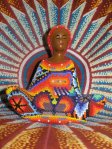 Malaika Mutere, Ph.D. is author of Towards an Africa-centered and pan-African theory of communication: Ubuntu and the Oral Aesthetic perspective Communicatio 38 (2) 2012: 147-163
Malaika Mutere, Ph.D. is author of Towards an Africa-centered and pan-African theory of communication: Ubuntu and the Oral Aesthetic perspective Communicatio 38 (2) 2012: 147-163


I’d must check with you here. Which isn’t something I usually do! I get pleasure from reading a post that may make folks think. Additionally, thanks for allowing me to comment
Thank you for your comment! I’d like to think that the Africa-centered and matriarchal perspective allows us to revisit our lessons and rethink them in a more life-affirming and humanizing way. This is the 3rd in a trilogy of posts that began with my take on “The Language You Cry In.”
st(Asset) Isis, creates the Ass-of-Ur i.e, the Ass~Seat.
Isis’ name is composed of 2 hisses of the sacred asp(s) of Isis(S). Her original name st is composed of the hiss of the sacred asp + the fang of the sacred asp. The fang of the asp was the original wisdom tooth.
IESOUS(J+Isis/Jesus) = the Beard-of-Isis. He replaces the Goddess of Love.
“thy King cometh unto thee: he is just, and having salvation; lowly, and riding upon an ass, and upon a colt the foal of an ass.”
It is wise to be mindful of (i) using the tool of an abstract & sequential western alpha-bet in our bid to become more discerning, & (ii) the colonizing effects spell-ing can have when original names, concepts, & pronunciations are distorted. Thank you for this interesting reminder @Anonymous…
Our Pagan Latin/Roman alphabet contains the legend of Assur and Isis. It cannot be fabricated to fit.
The minuscule letter s and t_t_t are striking asps.
The name of the throne is the “Ass” Essentially named. We sit on our ass. MSR(Mother Isis UrRea ~ Miser) spoke UrRean languages. They don’t speak Egyptian until the unification. We speak UrRean(Aryan) language. Now known as PIE.
Isis was in Miser. She was miserable over the death and dismemberment of her primeval king, El. Her tears annually flooded the Miserae river. The Missouri is her namesake. You can fill a large dictionary with Mother Isis water ~ Isis water names in North AmUrReca’. The Ohio dragon was the frontier. Isis’ ‘UrReIsis(uraeus) religion was worldwide. Essenes = Isis~sons.
MiSSiSSippi, SquaMiSh, MiChigan, MuSkoka, MaSSaSauga, Issaquah, SuSquehanna etc. S + aqua = Isis water, a Squa is a daughter of Isis.
Pingback: Re-Membering the Goddess |
Pingback: “I Find Myself On Earth”: Fka Twigs the Sangoma and the Osirian Resurrection of Afro-futurism in RadiantMe2 at Pier6 (part 3) – Calling Our Mother's Names
Pingback: Pyramid Wisdom & Story |
Pingback: Kuntu: A Well-Painted Home |
Pingback: Nyabingi ~ Oracle of the Drum & Warrior Queen |
Pingback: Panther ~ Black Rite-of-Passage? |
Pingback: Auset ~ Divine Seeker |
In the cultural spiritual tradition of south and south western uganda, nothern tanzania etc, Auset is mirrored, in the worship of the great mother, cleanser of spirits, protector of kings, (breast) feeder of victorious warriors and patron of homes and marriage.She ranks second after God himself and all the gods and ancestors came to be through her.
The throne of the king is incidentally, also considered a female entity in buganda and some other kingdoms. It bestows favor on the king and justifies whichever king has made the ascension. However in ankole karagwe and some other kingdoms, the throne is instead the state drum which represents the founding ancestor(s) and thus the people themselves and the land upon which they dwell.
Asante sana for your comments, Daniel. I look back on my colonial education and wish the words you write about Auset had been conveyed to me rather than the whitewashed version which robbed me of my African vision, hence consciousness. When the God of Revelation [3:11] says “Let no man take thy crown,” I understand this as the seat/throne of our consciousness which, when fully awake represents the ascended king/queen/god[dess]/light… Colonizers had no similar representation in their gold/bejeweled royal crowns which to me shamelessly represent the spoils of their conquest/thievery.
I pray that the spirit of Auset, ‘cleanser of spirits, protector of kings…’ return to the source of the Nile to undo the spell that was cast upon Africa, so the drum/heartbeat of this giant may once again awaken and sound with a conscious free-quency. Peace, M
Pingback: “Nakumbuka” ~ The MA’ATrix Re-membered | Malaika Mutere
Pingback: When & Where I Enter | Malaika Mutere
But our “kings” are now corrupt. Nature is in process of returning to the old, before Eden. Let those who have true ancient knowledge hear: Nature is in process of returning to the old, before Eden (the discovery of “gender”).
Interesting & welcome perspective @New-Being… reminds me of some of the ancient proverbs from Amun-Mut’s Ipet-Resyt Temple, now called Luxor. [Ref: https://malaikamutere.com/2015/06/25/proverbs-from-luxor-temple-of-amunmutmontu/ ]. IMHO the order to “control & subdue nature” likely jump-started the spiral into the corruption of its human element, following the dictates of its rulership class. Peace ☮️ M
Pingback: “NaKumbuka Day” ~ 11:11. Re-Membering the MA’ATrix | Malaika Mutere
Pingback: An Epiphany on Palm Sunday – Art ∩ Mel
I used google search to see if there was any information regarding Auset finding Ausar’s heart -in her quest to re-member. Google returned your page as four in my quest! I really need your work to be a book that I can purchase!!! Although, I am grateful that google’s results page has a been so good to me every time I look for our antiquity.
Sis, I’m so glad we connected on here! 💓💓💓
Greetings, Sis💓💓💓 Thanx for the encouraging stats & much needed nudge. I’ve been busy finishing up 2 book-writing projects, one which I want to self-publish. I still have in mind the blog-to-book as a follow-up. Any recommedations on a good self-publishing route/company that’s not going to break the bank upfront? Wishing you all the Very Best during this Eclipse Season & Beyond! ☮️ M
Sis, Yes I do! I’ve published my first book on my own through Lulu.com back in 2006. I learned so much through the process. Contact me and I can share cost and time-saving steps.
Also you’ve given me a great idea for a new blog post. I’m sure others probably have the same question 😀
I would love to introduce you to my alumni who is literary insider who has appeared on the Wall Street Journal future of publishing panel. He is now a publisher too! “Running to Fall (a novel) by Kalisha Buckhanon was his first release.
Please check out aalbc.com to gain some insight into work. I know you have a lot to share with the world and I will absolutely pitch and praise your work to him. Let’s chat!
Brilliant, Sis!!! 👏🏽 Plz give me a couple weeks to finish up my final edits while I’m in creative-mode, & I’ll follow-up with you for sure on the way forward as you’ve so generously offered. I’m still in sticker shock from my most recent consultation to self-publish – an all-inclusive @$6K/package!!! My big concerns were maintaining editorial control over the content… being able to publish on my schedule… & a couple other strategic things we can chat about. Thanx for the great link to aalbc.com + I’ll look out for your words of wisdom & advice in your upcoming post that I’m sure will be of great help to many seeking a trauma-free route to publishing. 🕊️💖🙏🏽🤗M